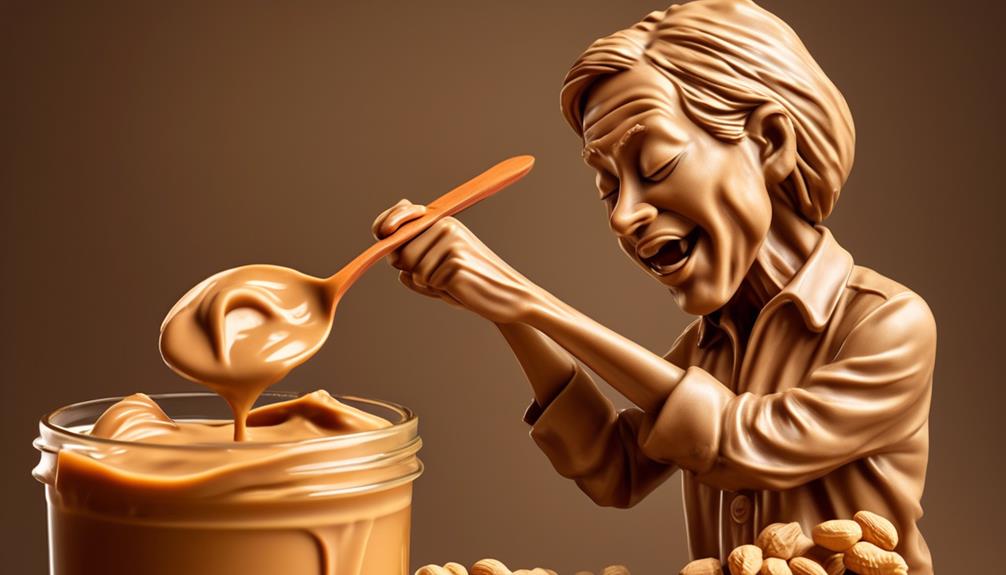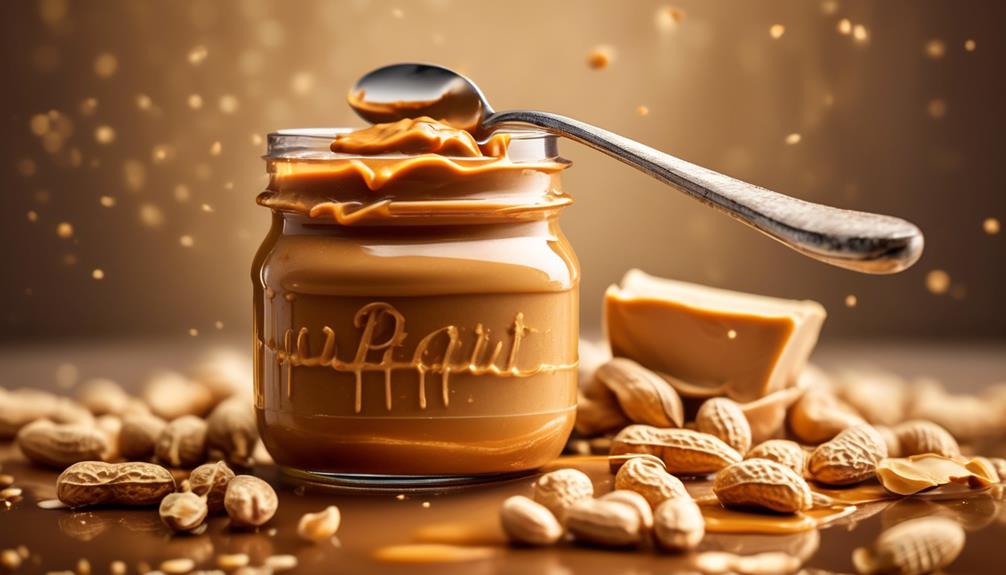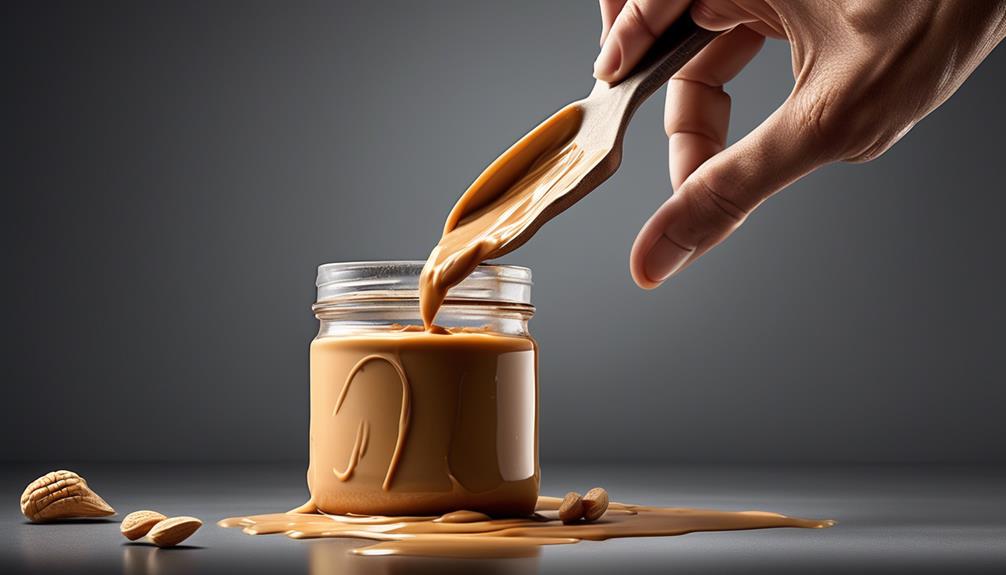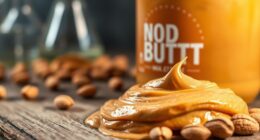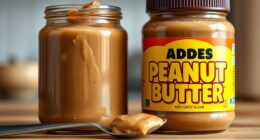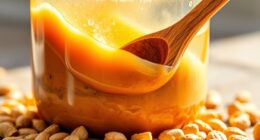We often overlook the fact that tasting peanut butter can be a multi-sensory experience. From its aroma to its texture, there's a lot to consider when savoring this beloved spread.
But have you ever thought about the different varieties of peanut butter and how they might influence your tasting experience? Understanding these variations could open up a whole new world of peanut butter enjoyment.
Key Takeaways
- There are different varieties of peanut butter, including natural, processed, creamy, and crunchy, each offering unique taste and texture options.
- Peanut butter should be enjoyed in moderation due to its high calorie density.
- The visual appeal of peanut butter can provide insights into its flavor profile and potential added ingredients.
- Pairing peanut butter with complementary flavors and ingredients can enhance both taste and nutritional value.
Understanding Peanut Butter Varieties
When choosing peanut butter varieties, it's important to understand the distinctions between natural and processed options, as well as the impact of creamy versus crunchy textures on taste and recipe versatility.
Natural peanut butter, made solely from peanuts and salt, is a healthier alternative to processed versions that often contain added sugars and oils. It provides the authentic flavor of peanuts and offers a traditional peanut butter experience. On the other hand, processed peanut butter may appeal to those seeking a sweeter taste and smoother texture.
Additionally, understanding the difference between creamy and crunchy textures is crucial. Creamy peanut butter is smooth and easily spreadable, making it an excellent choice for sandwiches and baking. Meanwhile, crunchy peanut butter contains small peanut pieces, adding a delightful crunch to dishes. The choice between the two largely depends on personal preference and recipe requirements.
Furthermore, portion control is essential when consuming peanut butter due to its calorie density. Natural peanut butter, with its minimal ingredients, offers a pure and wholesome option. It allows for a fuller appreciation of the natural flavor of peanuts while maintaining a balance.
Understanding these peanut butter varieties empowers individuals to make informed choices that align with their preferences and dietary needs.
Utilizing Your Senses for Tasting

When it comes to tasting peanut butter, utilizing our senses allows us to fully experience its nuances.
We'll be focusing on:
- Sight and color
- Texture and consistency
- Aroma and fragrance
These aspects will provide us with valuable insights into the quality and flavor profile of the peanut butter we're tasting.
Sight and Color
Observing the rich brown or golden hue of the peanut butter provides an initial insight into its visual appeal and potential flavor profile.
When assessing the color of peanut butter, it's important to consider the following:
- Consistency and Texture: Notice whether the peanut butter is creamy and smooth or has a chunky, granular appearance.
- Variations in Color: Pay attention to any darker swirls or specks, as these could indicate added ingredients like chocolate or honey.
- Pairing with Different Colored Foods: Consider the visual appeal of pairing peanut butter with foods of varying colors, such as bright red strawberries or vibrant green celery.
- Incorporating Colorful Ingredients: Experiment with adding vibrant chia seeds or colorful granola on top of the peanut butter for added visual interest.
Texture and Consistency
Assessing the texture and consistency of peanut butter is crucial in understanding its tactile properties and overall sensory experience. When tasting peanut butter, it's essential to pay attention to its smoothness or grittiness, as well as the thickness and mouthfeel. To help you better understand, here's a table highlighting the key aspects to consider:
| Aspect | Description |
|---|---|
| Smoothness | Notice if the peanut butter feels creamy or has a grainy texture. |
| Thickness | Consider how easy it is to spread and if it feels dense or light. |
| Mouthfeel | Observe if the peanut butter feels creamy, sticky, or dry when chewed. |
Paying attention to these aspects will allow you to fully appreciate the texture and consistency of the peanut butter, whether it's creamy, smooth, or natural.
Aroma and Fragrance
Engaging our sense of smell to take in the aroma of the peanut butter can greatly enhance our sensory experience when tasting it. The fragrance of peanut butter can provide valuable insights into its flavor profile and quality.
When exploring the aroma and fragrance of peanut butter, consider the balance of sweet and savory notes, the scent of roasted peanuts, and the creamy undertones. Pay attention to any subtle or strong fragrances, as they can significantly influence your perception of taste.
Additionally, observe how the aroma evolves as you taste the peanut butter, as it can reveal layers of flavors and enhance your overall sensory experience.
Pairing Peanut Butter With Complementary Flavors

When it comes to enhancing the taste of peanut butter, pairing it with complementary flavors opens up a world of possibilities.
From sweet and fruity combinations to savory and indulgent treats, the options are endless.
Flavorful Peanut Butter Combinations
Pairing peanut butter with complementary flavors creates a delightful and satisfying culinary experience, enhancing both the taste and nutritional value of various dishes and snacks.
Our taste buds are in for a treat when we combine peanut butter with the following flavors:
- Sliced fruits: The natural sweetness of apples or bananas complements the rich, nutty flavor of peanut butter, offering a satisfying and nutritious snack option.
- Whole-grain goodness: Spreading peanut butter on whole-grain toast or multigrain bagels introduces a delightful blend of flavors while providing essential nutrients and fiber.
- Savory sandwiches: Use peanut butter as a base and add ingredients like sliced turkey, cheese, or pickles for a unique and savory twist.
- Indulgent treats: Incorporate peanut butter into baked goods like cookies, brownies, or cakes for a nutty and satisfying flavor addition to your daily diet.
Enhancing Peanut Butter Taste
To enhance the taste of peanut butter, consider pairing it with complementary flavors such as fruit, savory ingredients, and incorporating it into various recipes to create a delightful and satisfying culinary experience.
By adding a dollop of peanut butter to fresh apple slices or spreading it on a banana, you can enjoy the classic combination of peanut butter and fruit, creating a delicious and nutritious snack.
For a savory twist, try pairing peanut butter with turkey or cheese in a sandwich, or adding it to hummus for a creamy and rich flavor.
You can also enhance the nutty taste of peanut butter by incorporating it into smoothies, oatmeal, or baked goods.
For a touch of natural sweetness, drizzle a bit of honey over smooth and creamy peanut butter, elevating its flavor profile.
Exploring Texture and Mouthfeel

As we delve into the exploration of texture and mouthfeel in peanut butter tasting, our attention is drawn to the thickness and smoothness of the spread, which significantly influence the overall sensory experience.
- Coating Sensation: Pay attention to how the peanut butter coats the tongue and the roof of your mouth, noticing whether it feels sticky, creamy, or gritty.
- Chewing Experience: Chew the peanut butter slowly and observe how it breaks down in your mouth, noting the level of creaminess and if there are any noticeable grainy or crunchy textures.
- Lingering Sensations: Take note of any lingering sensations or aftertastes the peanut butter leaves in your mouth, such as a dry or oily feeling, and how it complements the overall flavor profile.
- Physical Sensation: Consider the physical sensation of eating the peanut butter, including how it melts on the palate, and the overall satisfaction or fullness it provides.
Exploring the texture and mouthfeel of peanut butter allows for a deeper understanding of its sensory attributes. Whether it's the creaminess, grittiness, or how it coats the mouth, these elements contribute to the overall tasting experience. By paying attention to these aspects, one can truly appreciate the nuances of this delicious and nutritious spread.
Experimenting With Creative Peanut Butter Recipes

Exploring the sensory attributes of peanut butter through texture and mouthfeel, we now turn our attention to the realm of creative peanut butter recipes, where this versatile spread can be utilized in a multitude of innovative and delicious ways. Incorporating peanut butter into our daily diet can be an exciting and flavorful experience for both kids and adults.
One creative idea is to use peanut butter in homemade granola bars or energy balls, providing a nutritious and convenient on-the-go snack. Additionally, peanut butter can be used as a dip for pretzels, carrots, or celery sticks, adding a unique twist to a quick and satisfying snack.
Experimenting with peanut butter in cooking can lead to delightful discoveries. For instance, blending peanut butter with a sauce offers a unique flavor combination that can be a great accompaniment to fried foods. Moreover, adding peanut butter to hummus creates a unique flavor twist that can elevate the taste of the traditional dip.
Tips for Hosting a Peanut Butter Tasting Event

Hosting a peanut butter tasting event involves careful planning and consideration to ensure a delightful and engaging experience for all participants. Here are some tips to help you host a successful peanut butter tasting event:
- Variety is Key: Offer an array of peanut butter types, including creamy, crunchy, natural, and flavored options. This variety will allow participants to experience the diverse flavors and textures that peanut butter has to offer.
- Pairings: Provide an assortment of foods to pair with the peanut butter, such as different types of bread, crackers, fruits, and even savory items like cheese and pretzels. This will enhance the tasting experience and allow participants to explore the versatility of peanut butter.
- Guided Tasting: Consider providing a guided tasting experience, where participants are encouraged to take note of the aroma, texture, and flavor profile of each peanut butter sample. This will help them appreciate the nuances of each type.
- Interactive Element: Incorporate interactive elements such as blind taste tests or voting for favorite peanut butter pairings. This will make the event more engaging and memorable for the participants.
Frequently Asked Questions
How Do You Add Taste to Peanut Butter?
We add taste to peanut butter by experimenting with various spreads and toppings, such as honey, bananas, or Nutella, to create unique flavor combinations for sandwiches.
We also use it as a base for savory sandwiches by adding ingredients like sliced turkey, cheese, or pickles for a twist on traditional flavors.
Additionally, incorporating peanut butter into baked goods like cookies, brownies, or cakes offers a nutty and indulgent treat.
How Do You Like the Taste of Peanut Butter?
We love the taste of peanut butter for its rich, nutty flavor that pairs well with sweet ingredients like jelly or savory foods like celery.
It's versatile, and experimenting with different brands and textures can enhance the experience. We appreciate the importance of quality and natural ingredients to ensure an authentic taste.
How Was the Taste of Peanut Butter?
The taste of peanut butter was absolutely delightful. It had a rich, creamy texture with a perfect balance of nuttiness and sweetness. We enjoyed the smooth consistency, which added to the overall experience.
The natural, pure flavor of the peanut butter shone through, making it a perfect complement to both sweet and savory dishes. It's incredible how versatile and delicious peanut butter can be, especially when paired with fruits, bread, or chocolate.
What Is the Best Way to Enjoy Peanut Butter?
We enjoy peanut butter best when paired with healthy foods like whole-grain bread, apple slices, or celery sticks for a balanced and nutritious snack.
Experimenting with different spreads and toppings like honey, bananas, or Nutella helps create unique flavor combinations for peanut butter sandwiches.
Using peanut butter as a dip for pretzels, carrots, or celery sticks makes for a quick and satisfying snack.
Blending peanut butter with a sauce offers a unique flavor combination to complement fried foods.
Conclusion
In conclusion, tasting peanut butter is an exciting and versatile experience. Whether you prefer creamy or crunchy, there are endless ways to enjoy this delicious spread.
From breakfast options to savory sandwiches and sweet treats, peanut butter can be incorporated into a variety of dishes.
So, why not host a peanut butter tasting event and explore the endless possibilities of this beloved ingredient? The options are endless, and the flavors are sure to delight!
